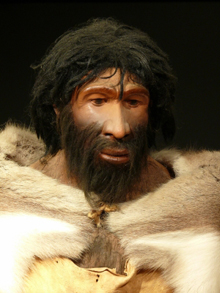Studying Neanderthal Brain Development, One (Indirect) CT Scan at a Time
Posted on Categories Discover Magazine

When you were born, your brain was more elongated than it is now; it rounded out into its more globular shape as you grew up and crammed it full of knowledge. Neanderthals, it appears, were born with brains in that same elongated shape. But in their case it never changed: Adult Neanderthals’ brains didn’t move to the more rounded shape like ours, according to a study now out in Current Biology.
Scientists have long known that Neanderthals had brains that were about as big as our own, but this study may help explain how their cognitive abilities differed.
[The researchers used CT scans] to study nine fossil Neandertals, including a newborn, a year—old baby, and three children. Because the brain does not fossilize, they studied endocasts, imprints of the brain left in the skull. They found that at birth, both Neandertal and modern human infants had elongated braincases that were similar in shape, although Neandertal faces were already larger. But by age 1 or so, modern humans had grown globular brains, whereas Neandertal babies had not. [ScienceNOW]
Neanderthals, in keeping the same basic brain shape throughout life, maintain the pattern of brain development seen in chimpanzees. In contrast, modern humans have evolved a unique pattern, says lead researcher Philipp Gunz:
The overall shape of the brain probably does not have too much significance in and of itself toward brain function, “but I would say that it does reflect changes in the pattern and timing of the growth of the underlying brain circuitry,” Gunz said. This internal organization of the brain is what matters most for mental ability. “In modern humans, the connections between diverse brain regions that are established in the first years of life are important for higher-order social, emotional, and communication functions,” Gunz said. “It is therefore unlikely that Neanderthals saw the world as we do.” [CBS News]
Attempts to interpret Neanderthals’ level of cognition through artifacts and bones are fraught with difficulty and revision. But, Gunz says, knowing the shape of the developing Neanderthal brain should provide more clues to their mental development (earlier studies suggest their brains grew faster than humans’ brains), and perhaps what gave Homo sapiens a competitive advantage over them.
“Only a few genes separate modern humans from Neanderthals, some of which are related to the brain,” Gunz said “What our results suggest is that these genes might be linked with the speed and pattern of brain development.” [CBS News]
Related Content:
Gene Expression: Size Doesn’t Always Matter
80beats: Evidence of Smart, Jewelry-Making Neanderthals Is Challenged
80beats: Controversial Study Suggests Early Humans Feasted on Neanderthals
80beats: Rough Draft of the Neanderthal Genome is Complete
Image: iStockphoto